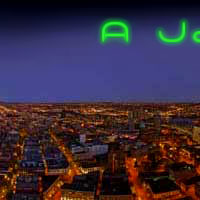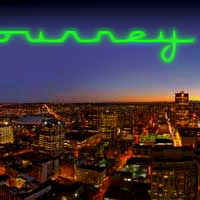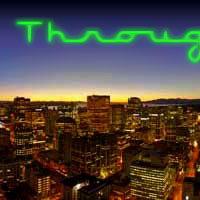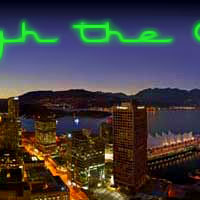
End
of the Luv-a-Fair
The
demise of the legendary nightclub closes the door on a unique
offbeat spirit -- and three decades of clandestine sex, drugs
and alternative music
Kerry Gold
Saturday, February 08, 2003
When
the Luv-a-Fair closed its doors for the last time last Saturday,
it was the last gasp for generations of giddy club kids who craved
something edgy alongside their cheap gin and tonics.
For
the not yet jaded or weary, it was the Vancouver night scene's
most thrilling spectacle for most of three decades. For a good
many Vancouverites from disco age and younger, the heyday of the
Luv-a-Fair at Seymour and Drake was the heyday of Vancouver's
club scene.
The
DJs played alternative music and they ruled, although there was
the occasional live act, too, including Nina Hagen, Killing Joke,
the Subhumans, Sonic Youth, the Violent Femmes, singer Divine,
Wall of Voodoo, Nine Inch Nails (the not yet legendary band got
paid $5,000 US and played to about 100 people in 1989).
Curious
celebrities showed up. The Cure and U2 regularly crashed the party
whenever they would play in town. As did Supergrass, Skinny Puppy,
Smashing Pumpkins, Pearl Jam, Soundgarden, Moe Berg, Marilyn Manson,
Blur, the Pixies, Hole, Village People, Ministry and Talking Heads.
And the movie people, too: Mark Wahlberg, Tom Cruise, Farrah Fawcett,
Johnny Depp and Ray Liotta.
And
of course, there was lots of sex, drugs and a little violence
thrown into the party mix. Matches were made, hearts were broken.
The men's washroom was notorious for drugs and promiscuity, and
was one of the liveliest in Vancouver, according to the men. Legend
had it that a massive skinhead named Chainsaw got into a fight
with the bouncer and pulled off the front door. Drug use wasn't
overt, but you didn't have to look hard if you wanted to find
it.
"That's
when I was introduced to the joys of amyl nitrate," says musician
and author John Armstrong, referring to more commonly known "poppers."
"You could just feel your brain cells dying." Armstrong -- who
wrote about his debauched years as punk rocker Buck Cherry, frontman
for the Modernettes, in his book Guilty of Everything -- says
his induction to the city began at the Luv-a-Fair.
"The
first time I ever came to Vancouver was 1976, and I went to the
Luv-a-Fair with [artist Jim] Cummins," says Armstrong. "I was
about 16 years old, so I felt like I'd walked into a Fellini movie.
"Do
you remember Roller Girl in the movie, Boogie Nights? There was
one there, except he was a tall skinny guy with a moustache. It
was extremely decadent. There was tons of drugs, and we were all
young and fresh faced. And the reason we all went there is because
they played the import stuff."
Not
that Armstrong remembers any of the DJs. "I was too busy trying
to get older gay men to get me drugs and buy me drinks."
In
the late '70s, early '80s, it transformed from a strictly disco-playing
gay bar to punk rock and new wave sanctuary -- while every other
club in town played Top 40. Through the dry ice billowing across
the dance floor, you might see a mile-long drag queen lounging
across one of the speakers. The speakers perfectly symbolized
the place's tongue-in-cheek, see-and-be-seen philosophy. They
were the display pedestal for the best-dressed, best-looking,
or simply the vainest or highest.
When
the Luv-a-Fair was at its peak, you felt like anything could happen,
or anybody could walk through the doors.
"My
fondest memory is looking across from the DJ booth one night when
I was playing in the late '80s and seeing Dave Gahan and Martin
Gore from Depeche Mode both dancing on the raised speakers, to
their own song, Master and Servant," says former long-time Luv-a-Fair
DJ David Hawkes.
Aside
from an evolving state-of-the-art sound and light system, the
decor never changed much.
"If
it was broken or dirty we used to say, 'Paint it black,'" remembers
Hawkes.
A
dark DJ booth that started out on the floor was soon raised to
a dark corner over the stage, and beneath it, a red digital read-out
that displayed the upcoming track (this was to discourage people
from bugging the DJ with requests). TVs around the downstairs
bar area might loop a movie like Altered States ad nauseum, while
Iggy Pop's Warm Leatherette or Trio's Da Da Da blared so loud
that your chest cavity kept time with the chinking cubes of ice
in your glass, which were a ghostly violet hue beneath the black
lights. There was an upstairs mezzanine, with pool tables and
a chain link fence. Black was the uniform; hair was ratted; fishnets
torn.
"The
first time I went there it was back in the late '70s, and we all
got in there underage, and I saw that weird purple world that
I'd only known from magazines," says author Michael Turner. "And
I'd never seen it around Vancouver before. It was an indication
that I was living in a contemporary world. So of course, I felt
very grown up.
"But
I do remember wanting to never have to go to the bathroom."
When
Nick Kerasiotis and his five brothers paid about $1 million for
a defunct nightclub called the Garage in 1975, they couldn't have
imagined its impact on the impressionable lives of so many kids.
They started it as a gay club, chose a name that fitted the scene,
and soon pulled in a crowd that sought the alternative side of
music, too. By the late '70s, Disco Duck and Donna Summer tunes
had begun to wear out their welcome, and Hawkes believes he witnessed
a pivotal moment not just in Luv-a-Fair history, but popular culture
history. After the Kerasiotis brothers made the switch from beloved
progressive disco DJ Richard Evans, to one who catered to a decidedly
straight crowd and artists like the Cramps and the Clash, change
did not come easily. In fact, it nearly caused a war. One night
the disco-loving crowd chose to revolt by sitting down on the
dance floor. But the Kerasiotis brothers had read the mood of
popular culture, and deemed that it was time for a change. Perhaps
their greatest strength was that ability to gauge the climate
and choose DJs appropriately.
"The
Greeks were great bosses," says George Maniatis, a former Luv-a-Fair
DJ. "But this was a business to them, and they made a lot of money
over the years. And if you made money, you were family. If you
didn't, you were out. It was like being in the mob."
By
the early '80s, because of its gritty reputation, it earned the
affectionate nickname "the Scuz." Kerasiotis recalls hearing the
tag in 1983, and he nods and laughs at the memory. "It was because
it was the most crazy," he says simply.
Most
significantly, perhaps, it was the first club to celebrate the
DJ -- invisible in his opaque pulpit, the all-knowing, keenly
intuitive lord and master of the evening's ceremonies. Kerasiotis
is still proud of those DJs, who became known, if not at the time,
then later. Hawkes DJ'd at the Luv-a-Fair from 1985 to 1987 and
again from 1990 to 1997. Media personality and former MuchMusic
VJ Kim Clark Champness was there in the early days. Nettwerk Records
chief Terry McBride DJ'd there from the early '80s to about 1987.
So did Maniatis, the artist and repertoire V-P for Nettwerk.
"From
the late '70s to the '80s, you had Luv-a-Fair, Graceland, Faces.
The rest of the city was inundated with Top 40 clubs," says Maniatis,
who occupied the booth from 1987 to 1994. "People realized that
these DJs at these really cool clubs had access to all this music
that nobody else had access to," said Maniatis. "Nobody would
hear this music anywhere."
The
place became internationally famous for its progressive club chart.
Maniatis remembers regularly informing influential New York trade
magazine Rockpool of the club's playlist.
"In
the early days nobody knew what alternative music was, so record
companies read magazines like Rockpool and signed bands according
to what DJs were playing," says Maniatis. "We would only play
records at our clubs that were hits, so it was instant feedback.
We were very, very important. They watched our playlists."
Turner
recalls getting to the Luv-a-Fair early in the evening to witness
the DJ changing gears, gauging the mood of the crowd that was
emerging for the night, adjusting the sound appropriately. He
went on Mondays when he busked on Robson Street with punk rock
roots outfit the Hard Rock Miners, in the late '80s and early
'90s. Turner hadn't written any books or art criticisms or opened
the Malcolm Lowry Room yet; he was just a low-income guy in a
band, knocking around ideas. So it was fitting that the cocktails
were 99 cents, even if they were heavy on the mixer.
"We
would take our bags of quarters and loonies and go down there
and have a great time," he recalls. "And for a time there, everything
that meant anything to me was intersected at that place -- and
in that sense, it was definitely an important place for me."
On
the outside, it remained a nondescript concrete block of a building,
but on the inside, it was a sea of dressed-up kids working hard
to affect a look of utter indifference, no matter how intimidated
they might be feeling on the inside. Michael Barrick, a goth kid
who lived in Nanaimo and would go to Vancouver in the late '80s
just for the Luv-a-Fair, remembers the feeling.
"Because
we were from out of town, young, and a little insecure, we generally
kept to the small, raised seating area below the DJ booth," he
says. "The 'real' regulars hung around on the other seating area
beside the dance floor, in what came to be known as "The Goth
Box." They were the ones with the great clothes that we couldn't
afford or just plain couldn't get on the Island and, at the time,
we were intimidated by them. Later on, once I was living in Vancouver,
I discovered that they were just people, and eventually ended
up spending all my time in the Goth Box as well."
It
was a packed house the final night, filled with former goth kids
like Barrick, as well as former and current punks, preppies, skater
kids, mods, whatever, who staked out favourite tables and re-lived
the glory days.
The
Kerasiotis brothers still own the Plaza on Granville Street and
Celebrities on Davie Street, which is re-opening in the summer
after renovations. They are also owners of the Caprice, which
is the follow-up to the Luv-a-Fair crowd, set to open March 15.
(The Luv-a-Fair is under negotiation to be sold, and will face
the wrecking ball to make way for the Yaletown area's spreading
rash of condominiums.)
But
the Luv-a-Fair was their first club, and the brothers owned the
place until its closing bash last Saturday, so it wasn't an easy
thing to see their first baby die. It was a sold-out evening,
and a low-key Kerasiotis observed from a side table with friends.
Kerasiotis, who came from a Greek island in his early 20s, is
quiet, greying, conservative-looking and not what you'd expect
as the owner of the city's most outrageous landmark.
"Yes,
it is very sad," he says, nodding, looking genuinely saddened.
"That was an end of an era, yes. I had a lot of people who said,
'Don't close. Stay.' But ...."
He
shrugs. "But everything has an end, huh?"
After
all, Luv-a-Fair's arch rival, Graceland (which the Kerasiotis
brothers also owned), died first. And that's in spite of the fact
that Luv-a-Fair wasn't always the coolest joint in town, falling
victim to bouts of mainstream ennui, particularly in the late
'90s.
But
it won't be the drugs, or the sex, or the posing, or even the
illustrious DJing that went on at the Luv-a-Fair that will be
best remembered. Its most endearing quality was that until the
end, it simply welcomed anybody, and nobody cared what you wore
or who you were.
"It
was just a nice safe place where you didn't run any risk of having
to defend your taste in straight legged Levis," says Armstrong.
"Because honestly you risked your life to get on a bus with short
black hair and straight legged pants -- either you were [gay]
or a punk and either way you deserved a beating."
Says
Hawkes: "Luv-a-Fair was built on the open-mindedness of most of
the clientele. Black lipstick and dressing like a bat never mattered.
The weirdos were in the suits, and even they weren't bothered
by the regulars."
For
those who contributed to and cherished the offbeat spirit of the
Luv-a-Fair, it was the perfect convergence of fantasy creation
and role-playing escapism, a world unto itself.
"Luv-a-Fair
at its best, or Graceland, these are perfect worlds," says Turner.
"It was a Utopian culture, in a sense. It expressed itself, and
it had to be just right. And that's a brilliant aspect of that
business."
|











